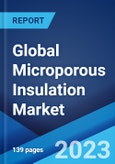The global microporous insulation market size reached US$ 154.8 Million in 2022. Looking forward, the market is expected to reach US$ 200.4 Million by 2028, exhibiting a growth rate (CAGR) of 4.4% during 2022-2028.
Microporous insulation is a composite material available in compact powder or fiber form with opacifiers. It offers compressive strength, minimal thermal shrinkage, excellent fire barrier, and resistance to liquids, vibration, and chemicals. As it is inorganic and non-combustible, it is considered suitable for passive fire protection applications. Besides this, it is widely used in refining and petrochemical manufacturing plants for industrial process piping and equipment. It is also utilized in filler material for mattresses, cassettes, heat shields, and expansion joints across the globe.
Microporous insulation is a composite material available in compact powder or fiber form with opacifiers. It offers compressive strength, minimal thermal shrinkage, excellent fire barrier, and resistance to liquids, vibration, and chemicals. As it is inorganic and non-combustible, it is considered suitable for passive fire protection applications. Besides this, it is widely used in refining and petrochemical manufacturing plants for industrial process piping and equipment. It is also utilized in filler material for mattresses, cassettes, heat shields, and expansion joints across the globe.
Microporous Insulation Market Trends
Microporous insulation is used in the nuclear steam supply system (NSSS) to control the heat of various elements, including reactors, pipes, pumps, and valves. The growing demand for nuclear energy due to the increasing consumption of electricity, along with the rising concerns about environmental pollution and climate change, acts as a major growth-inducing factor. Moreover, the increasing air traffic is catalyzing the demand for microporous insulation for heat shields and protection of data recorder boxes of airplanes. The rising exploration of oil and gas activities to deep-water areas is also promoting the use of microporous insulation in subsea pipelines. Apart from this, it is employed in the automotive industry to meet specified heat loss requirements. As microporous insulation is environmental-friendly, it is gaining traction in road, marine, and railway applications. Furthermore, its escalating demand in the energy and power, aerospace, and defense sectors is strengthening the market. Additionally, major market players are investing in research and development (R&D) activities to develop innovative product variants and meet constantly changing consumer needs. They are also offering high-quality acoustic insulation, which is anticipated to propel the growth of the market.Key Market Segmentation
This research provides an analysis of the key trends in each sub-segment of the global microporous insulation market report, along with forecasts at the global, regional and country level from 2023-2028. The report has categorized the market based on material, product and application.Breakup by Material:
- Alumina Silica
- Calcium Magnesium Silicate
Breakup by Product:
- Rigid Boards and Panels
- Flexible Panels
Breakup by Application:
- Industrial
- Energy and Power
- Oil and Gas
- Aerospace and Defense
Breakup by Region:
- North America
- United States
- Canada
- Asia-Pacific
- China
- Japan
- India
- South Korea
- Australia
- Indonesia
- Europe
- Germany
- France
- United Kingdom
- Italy
- Spain
- Russia
- Latin America
- Brazil
- Mexico
- Middle East and Africa
Competitive Landscape
The competitive landscape of the industry has also been examined along with the profiles of the key players being Elmelin Ltd., Etex Group, Isoleika S. Coop, Johns Manville Corporation (Berkshire Hathaway Inc.), Kingspan Group Plc, Morgan Advanced Materials plc, NICHIAS Corporation, Siltherm Group Holdings Limited, TECHNO-PHYSIK Engineering GmbH, Unicorn Insulations Limited and Unifrax LLC.Key Questions Answered in This Report:
- How has the global microporous insulation market performed so far and how will it perform in the coming years?
- What has been the impact of COVID-19 on the global microporous insulation market?
- What are the key regional markets?
- What is the breakup of the market based on the material?
- What is the breakup of the market based on the product?
- What is the breakup of the market based on the application?
- What are the various stages in the value chain of the industry?
- What are the key driving factors and challenges in the industry?
- What is the structure of the global microporous insulation market and who are the key players?
- What is the degree of competition in the industry?
Table of Contents
1 Preface3 Executive Summary11 Value Chain Analysis13 Price Analysis
2 Scope and Methodology
4 Introduction
5 Global Microporous Insulation Market
6 Market Breakup by Material
7 Market Breakup by Product
8 Market Breakup by Application
9 Market Breakup by Region
10 SWOT Analysis
12 Porters Five Forces Analysis
14 Competitive Landscape
Companies Mentioned
- Elmelin Ltd.
- Etex Group
- Isoleika S. Coop
- Johns Manville Corporation (Berkshire Hathaway Inc.)
- Kingspan Group Plc
- Morgan Advanced Materials plc
- NICHIAS Corporation
- Siltherm Group Holdings Limited
- TECHNO-PHYSIK Engineering GmbH
- Unicorn Insulations Limited
- Unifrax LLC
Methodology

LOADING...
Table Information
| Report Attribute | Details |
|---|---|
| No. of Pages | 139 |
| Published | November 2023 |
| Forecast Period | 2022 - 2028 |
| Estimated Market Value ( USD | $ 154.8 Million |
| Forecasted Market Value ( USD | $ 200.4 Million |
| Compound Annual Growth Rate | 4.4% |
| Regions Covered | Global |
| No. of Companies Mentioned | 11 |









